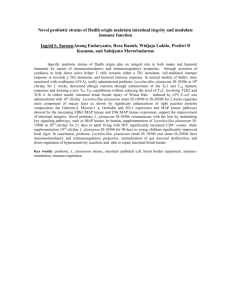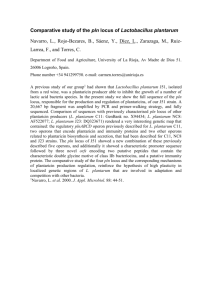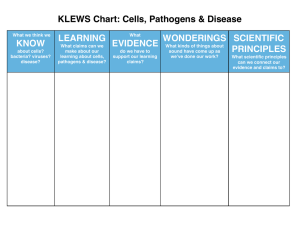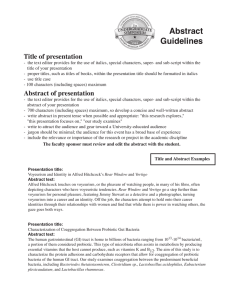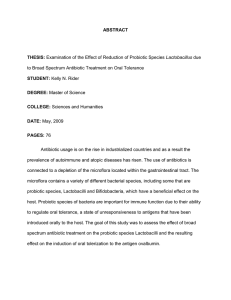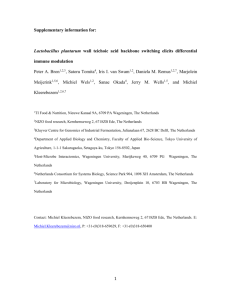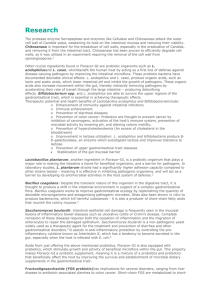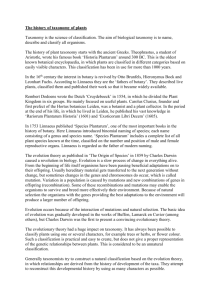as a PDF
advertisement
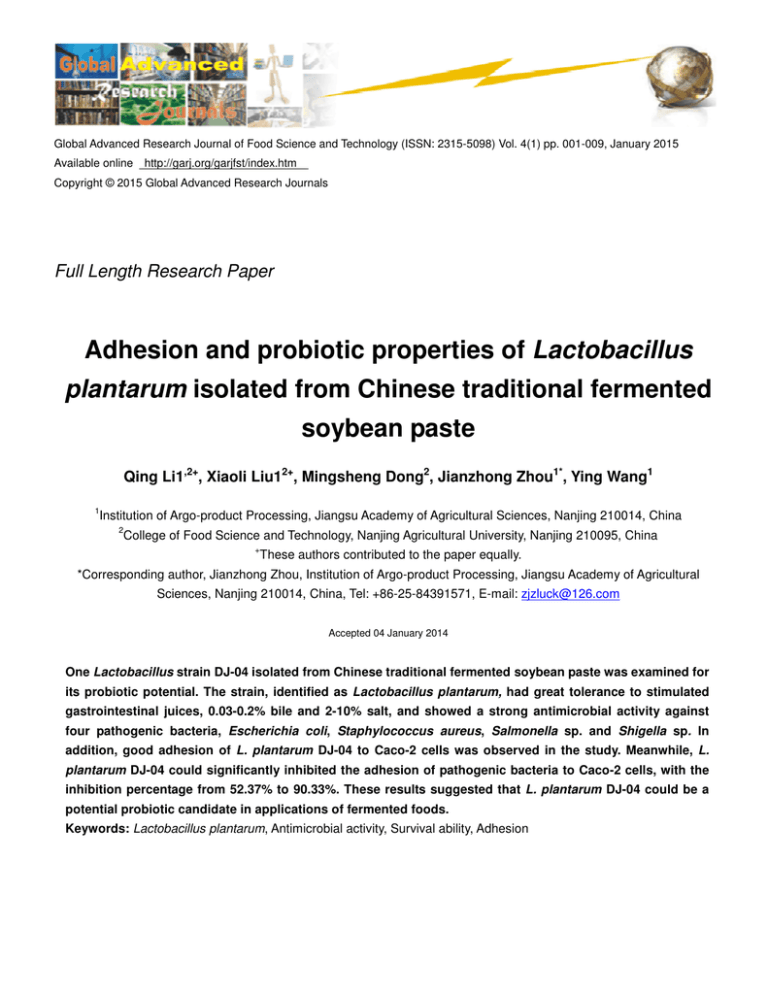
Global Advanced Research Journal of Food Science and Technology (ISSN: 2315-5098) Vol. 4(1) pp. 001-009, January 2015 Available online http://garj.org/garjfst/index.htm Copyright © 2015 Global Advanced Research Journals Full Length Research Paper Adhesion and probiotic properties of Lactobacillus plantarum isolated from Chinese traditional fermented soybean paste Qing Li1,2+, Xiaoli Liu12+, Mingsheng Dong2, Jianzhong Zhou1*, Ying Wang1 1 Institution of Argo-product Processing, Jiangsu Academy of Agricultural Sciences, Nanjing 210014, China 2 College of Food Science and Technology, Nanjing Agricultural University, Nanjing 210095, China + These authors contributed to the paper equally. *Corresponding author, Jianzhong Zhou, Institution of Argo-product Processing, Jiangsu Academy of Agricultural Sciences, Nanjing 210014, China, Tel: +86-25-84391571, E-mail: zjzluck@126.com Accepted 04 January 2014 One Lactobacillus strain DJ-04 isolated from Chinese traditional fermented soybean paste was examined for its probiotic potential. The strain, identified as Lactobacillus plantarum, had great tolerance to stimulated gastrointestinal juices, 0.03-0.2% bile and 2-10% salt, and showed a strong antimicrobial activity against four pathogenic bacteria, Escherichia coli, Staphylococcus aureus, Salmonella sp. and Shigella sp. In addition, good adhesion of L. plantarum DJ-04 to Caco-2 cells was observed in the study. Meanwhile, L. plantarum DJ-04 could significantly inhibited the adhesion of pathogenic bacteria to Caco-2 cells, with the inhibition percentage from 52.37% to 90.33%. These results suggested that L. plantarum DJ-04 could be a potential probiotic candidate in applications of fermented foods. Keywords: Lactobacillus plantarum, Antimicrobial activity, Survival ability, Adhesion 002 Glo. Adv. Res. J. Food. Sci. Technol. INTRODUCTION Lactic acid bacteria (LAB) are normal flora in the human imitative gastroenteric environments and its probiotic gastrointestinal and urogenital tracts, conferring beneficial properties, including the antimicrobial ability, adhesion effects on the health of the host (Collado et al., 2004), ability to Caco-2 cells and its competition-based adhesion such as inhibition on the invasion of pathogens, with pathogens. improvement of the epithelial barrier function and so on (Saxelin et al., 2005). In the past three decades, probiotics for beneficial gastrointestinal use had aroused MATERIALS AND METHODS great interest among different countries. Some strains of Lactobacillus (Lee et al., 2011; Ramos et al., 2013), The strain Bifidobacterium (O'Mahony et al., 2005; Weizman et al., 2005; Xiao et al., 2003), Enterococcuss (Reid and Bruce, The strain DJ-04 used in this study was isolated from 2006), Escherichia (Tromm et al., 2004) have been Chinese traditional fermented soybean paste. The bean explored as probiotics due to the growing evidence of paste was collected from local families at Anshun County, their health benefits (Alvarez-Olmos and Oberhelman, Guizhou Province, located in the southeast China. The 2001), and obviously, these strains have favorable whole soybeans naturally fermented with high salt content general aspects (origin, safety, acid and bile tolerance and and various spices after boiling and wilting. Five grams of identity), technical aspects (growth properties in vitro and paste were homogenized with 45 ml of 0.75% (w/v) sterile during processing) and functional and beneficial features saline in a 150 ml flask for 30 seconds and serially diluted. (Iqbal et al., 2014). Two hundred microliters of properly diluted sample were Various traditional fermented foods are made by the spread on MRS (Difco, USA) agar plates for isolation. The local people in many regions throughout China. As their Lactobacillus strain isolated was cultured in MRS broth at unique fermentation patterns, these products could be a 37°C for 20 h. Based on its 16s RNA sequence analysis meritorious source of native lactic acid bacteria. In order and microscopic morphology, the strain DJ-04 was to regulate the gastrointestinal tract and contribute healthy identified as Lactobacillus plantarum. The stock culture effect to the host, probiotic bacteria should survive was stored in 20% glycerol at -80°C. through the human gastrointestinal tract and colonize on the intestinal tract. The antimicrobial activity is also an important characteristic for the selection of probiotic Tolerance and survival assay bacteria, especially the competitive inhibition of the invasion and adhesion of pathogens to human intestinal The viability and survival of L. plantarum DJ-04 were epithelial cells. evaluated in simulated gastric juice, simulated intestinal Traditional fermented soybean paste with high salt juice, bile solution and NaCl solution, respectively. content is very popular as side dishes or mating dishes in Simulated gastric juice was prepared according to the China. Lactic acid bacteria isolated from such high-salt method described by Lucía (Abadia-Garcia et al., 2013) environment the with some modifications. Simulated gastric juice was fermentation of high-salt food, such as pickled vegetables, prepared by suspending pepsin (from porcine gastric sausages, seafood sauce and so on. In the previous study, mucosa, 250 units per mg, EC 232-629-3, Sigma we obtained one Lactobacillus strain from traditional Chemical Co., St. Louis, MO, USA) in a sterile NaCl fermented soybean paste. The main objective of this solution (0.5%) with the final concentration of 3 g/L and study is to evaluate its survival activity in high-salt and adjusting the pH to 1.5, 2.5, 3.5, 4.5 with 1.0 M HCl, and could be better candidate for Qing et al., 003 Table 1 The antimicrobial activity of L. plantarum DJ-04 against pathogens Lactobacillus plantarum DJ-04 supernatant(mm) supernatant treated(mm) Staphylococcus aureus 14.12±1.24 10.14±0.96 Salmonella sp. 13.06±0.68 12.08±0.24 Escherichia coli 12.24±0.42 9.88±0.62 Shigella sp. 11.46±1.02 10.06±0.78 Supernatant: cell-free supernatant. Supernatant treated: cell-free supernatant adjusted to pH 6.0 and treated with catalase. Table 2 Inhibition of pathogens adhesion to Caco-2 cells by L. plantarum DJ-04 Control Co-cultured with DJ-04 132.63±10.22 12.83±4.06 90.23±2.01 Salmonella sp. 95.26±8.09 16.98±6.23 82.49±5.02 Escherichia coli 104.84±11.98 38.11±10.87 62.52±14.74 84.66±6.23 40.32±9.14 51.67±14.39 Staphylococcus aureus Shigella sp. Inhibition rate (%) Note: Results were shown as values± SD. Viable count (Log CFU/mL) 8.5 8.0 7.5 7.0 6.5 6.0 5.5 5.0 0.0 0.5 1.0 1.5 2.0 2.5 3.0 Time (h) Figure 1 Survival of L. plantarum DJ-04 in stimulated gastrointestinal juices. (■) pH1.5 , (◆) pH2.5, (▲) pH3.5, (★) pH4.5, (▼) Simulated intestinal juice. then sterilized through 0.22 µm membrane (Millipore ,USA). concentration of 3.0 g/L and sterilized through 0.22 µm membrane (Chavarri et al., 2010) . The imitative intestinal juice was prepared by dissolving MRS broth was supplemented with cow bile at the final bile salts in intestinal solution (6.5 g/L NaCl, 0.835 g/L KCl, concentration of 0, 0.03, 0.1, 0.2, 0.3% (w/v) respectively, 0.22 g/L CaCl2 and 1.386 g/L NaHCO3, pH 7.5) to final and then sterilized at 121°C for 20 min (Liu et al., 2013), in 004 Glo. Adv. Res. J. Food. Sci. Technol. 9 Viable count (Log CFU/mL) 8 7 6 5 4 3 2 1 0 2 4 6 8 Time (h) Figure 2 Growth of L. plantarum DJ-04 in MRS with different concentration of bile. (□) 0%, control group, (●) 0.03% , (▲) 0.1%, (★) 0.2% ,(◆) 0.3%. 9.2 9.0 Viable count (Log CFU/mL) 8.8 8.6 8.4 8.2 8.0 7.8 7.6 7.4 7.2 7.0 6.8 6.6 6.4 0 2 4 6 8 10 12 14 16 18 20 22 Time (h) Figure 3 Growth of L. plantarum DJ-04 in MRS with different NaCl concern trations. (■) 0%, control group, (○) 2% ,(▲) 4% ,(◇) 6%, (►) 8% ,(☆) 10%. order to evaluate the tolerance of L. plantarum DJ-04 to MRS broth with different concentrations of NaCl, 0, 2, 4, bile. 6, 8 and 10% (w/v) were used to determine the Qing et al., 005 Figure 4. Adhesion to Caco-2 cells of L. plantarum DJ-04. Scale bar 20 µm. eliminate the possible role of hydrogen peroxide and lactic tolerance of L. plantarum DJ-04 to salt (Pan et al., 2009). In order to evaluate the survival viability of L. plantarum acid. The original and treated supernatants were filled into DJ-04 to the solutions described above, an inoculum of the agar well separately. MRS medium alone was used as 2% (v/v) bacteria was added to the above solutions the negative control in each plate. The plates were then respectively and incubated at 37°C. Samples were taken incubated at 37°C for 24-48 h. The diameters of the at different times for microbial plate counting. inhibition zone around the wells were measured. Each test was carried out in duplicate. Antimicrobial activity assay The agar well diffusion method was used to measure the Cell lines and adhesion assay inhibitory effect of L. plantarum DJ-04 on pathogenic bacteria (Ghanbari et al., 2013). Four pathogenic bacterial The human colon adenocarcinoma Caco-2 cell lines were strains, aureus, purchased from the Institute of Biochemistry and Cell Salmonella sp. and Shigella sp. were provided by Nanjing Biology, Chinese Academy of Sciences (Shanghai, China). Institute of Supervision & Testing on Product Quality Caco-2 cells were grown in Dulbecco’s modified Eagle’s 6 (Jiangsu, China). Luria-Bertani (LB) agar containing 10 medium (DMEM; HyClone, Laboratories Inc., Logan, UT, CFU/ml pathogenic bacteria was poured into 12-cm plates. USA) supplemented with 10% heat-inactivated fetal Wells with 7 mm in diameter were made. After incubation bovine serum (FBS; HyClone) and antibiotics (100 U/ml at 37°C for 24 h, the culture of L. plantarum DJ-04 was penicillin, 100 mg/ml streptomycin; Gibco) in an incubator centrifuged to get cell-free culture supernatant. The with 95% (v/v) humidified air and 5% (v/v) CO2 at 37°C. supernatant was devided into two portions. One was kept The bacterial adhesion assay was carried out according untreated, and the other portion was mixed with a sterile to the method of Nueno-Palop and Narbad (2011) with catalase solution (with the final concentration of 1000 U some modifications. Caco-2 cells were seeded on 12-well -1 Escherichia coli, Staphylococcus mL , Sigma) after adjusting pH to 6.0, in order to tissue culture plates (Corning, Inc., Corning, NY, USA) at 006 Glo. Adv. Res. J. Food. Sci. Technol. 5 a concentration of 2 × 10 cells per well and were cultured the three determinations. Paired t tests and analysis of at 37°C in a humidified atmosphere of 5% CO2 and 95% variance (ANOVA) were carried out with SPSS 11.0 air until a confluent monolayer was obtained. software. Caco-2 monolayers prepared in 12-well plates were washed twice with PBS (pH 7.2) to remove the excess RESULTS AND DISCUSSION free cells before the adhesion assay. The bacterial cells were harvested by centrifugation at 10,000 × g for 10 min Evaluation of L. plantarum DJ-04 to simulated human at 4°C and washed twice with PBS (pH 7.2), and then gut challenges re-suspended in DMEM (antibiotic-free, fetal bovine serum-free). 1 ml of the bacteria suspension The ability of DJ-04 to cope with the stressful human gut (1×10 CFU/mL) was added to each well and then conditions was evaluated by exposing the cells through incubated at 37°C for different hours in 5% CO2 simulated gastrointestinal tract environmental conditions. atmosphere. Wells were washed 4 times with PBS (pH The viability of L. plantarum DJ-04 after exposure to the 7.2) to remove unattached bacterial cells. Then, 1 mL of simulated gastrointestinal juices with different pH was 1% (v/v) Triton × 100 was added to corresponding well at shown in Figure 1. The harsh low pH condition decreased 2 h. The suspension was then stirred for 10 min, survival rate of DJ-04 greatly. At higher pH conditions, the detaching the cells from the well. Serial dilutions of the cell resistance of L. plantarum DJ-04 increased rapidly. suspension were plated onto MRS agar (for lactic acid Viability of DJ-04 upon pH 4.5 and 3.5 for 3h was 74.13% bacteria), Mannitol Salt agar (for Escherichia coli and 31.62% respectively, relative to unexposed original Staphylococcus aureus), and MAC agar (for Salmonella counting, considerably higher than those results of 0.08% sp. and Shigella sp. growth) plates and incubated at 37 °C and 6.31% for lower pH 1.5 and 2.5 (Figure 1). In order to for 48 h to determine the viable bacterial cells. exert the beneficial effects in human intestinal tract, 9 The competition assay was carried out to access the Lactobacillus should resist the stressful gastrointestinal effect of L. planturam DJ-04 on the attachment of conditions and keep certain transit tolerance. pH value in pathogens to enterocyte-like cells (Xue et al., 2013). human stomach ranges from 1.5 to 4.5 (Bao et al., 2010), Caco-2 monolayers and bacterial suspension were and in this study, L. plantarum DJ-04 had good resistance prepared as above. The mixture of 500µL pathogen to simulated gastric and intestinal juices, meeting the suspension and 500µL Lactobacillus suspension were prerequisite of exerting potential probiotic functions. injected into the wells. 500µL PBS instead of Lactobacillus The bile salt concentration in the human intestine suspension was used as the control. After incubated at different as time and segments of the intestine, the 37°C for 2 h in 5% CO2 atmosphere, monolayers was average concentration is believed to be about 0.3% (w/v) washed 4 times with PBS and afterwards the cells were (Garcia-Hernandez et al., 2012). Results in Figure 2 show lysed with 1% (v/v) Triton × 100. Serial dilutions of the the tolerance of L. plantarum DJ-04 to bile. Like the mixtures were then plated onto the Mannitol Salt agar (for control without bile salt, the viable cell counts in MRS Staphylococcus aureus growth), and MAC agar (for broth with 0.03% bile increased in the first 4 hours, while Salmonella sp. and Shigella sp.) plates, separately, and the growth in MRS broth with higher bile salt contents was incubated at 37 °C for 48 h to determine the viable immediately bacterial cell number. experiment. After 8 h incubation in MRS broth with 0.2% inhibited since the beginning of the 5 bile salt, the viable bacteria still reached about 10 Statistical analysis 3 CFU/ml, while only 10 CFU/ml left in MRS containing 0.3% bile. All the experiments were carried out three times independently. The data are presented as the average of The salt with high concentration can improve the flavour of the fermented food, and also inhibit the growth of Qing et al., 007 pathogenic bacteria. Mohd Adnan (2007) suggest that gastrointestinal tract and consequently conferring health lactic acid bacteria strain can grow in a concentration of benefits to the host (Tuo et al., 2013). Caco-2 has been NaCl less than 10%, because bacteria cells would mostly used as a cellular model since it displays the experience a loss of cell pressure, which would then affect characteristics of a mature enterocyte in vitro (Garc I the physiology, enzyme and metabolism of the cells. L. A-Cayuela et al., 2014).The L. plantarum DJ-04 showed plantarum DJ-04 had a significant survival ability to salt good adhesion ability to Caco-2 cells (Figure 4). After ranging from 0% to 10% (Figure 3). Lower content of salt co-inhibited with Caco-2 cells for 2h, L. plantarum DJ-04 below 4%, seemed to stimulate the growth of DJ-04. showed the greatest adhesion value of 78 ± 8.24 bacteria Higher content of the salt above 8% had an inhibition cells/Caco-2 cells (Figure 4). Many other studies showed effect on the growth of L. plantarum DJ-04, but the cells that lactobacilli have a strong adherence to epithelial cells. 7 Liu (2013) reported that the adherence of the L. plantarum counts could still reach to 10 CFU/ml. CCFM 233 to epithelial cells was 45.33 ± 5.78. Antimicrobial activity Competitive effect of DJ-04 on the attachment of Antimicrobial activity is recognized as an important pathogens to Caco-2 cells property for functional probiotics. Many papers have reported that Lactobacillus spp. have antimicrobial activity Pathogens, such as Staphylococcus aureus, Salmonella due to different factors. Production of organic acids and sp., etc., are responsible for a diverse spectrum of human bacteriocins are the main contributors to the antimicrobial and activity (Liu et al., 2013; Makras et al., 2006; Pan et al., demonstrated that adhesion of these pathogens to 2009; Zhang et al., 2011).The inhibition of L. plantarum intestinal epithelial cells is a key process to survive and DJ-04 against pathogen bacteria was shown in Table 1. colonize the gastrointestinal tract and mucosal infection The cell-free supernatant showed great antimicrobial (Mempel et al., 1998; Tristan et al., 2003). Adherence to activity to all the examined pathogen bacteria with the intestinal epithelial cells could bring adverse effects such inhibition as resulting in excessive growth of intestinal pathogens zone ranging from 12.62±1.14 mm to animal diseases, antibiotic and treatment increasing and evidence 14.47±1.56 mm. The treatment of adjusting pH to 6.0 and during leading to catalase weakened slightly the inhibition activity of the antibiotic-associated diarrhea (Ackermann et al., 2005; supernatant, by the percentage from 7.50% to 28.19%, Boyce and Havill, 2005). Inhibition of the adhesion and indicating the possible production of bacteriocins in the invasion of pathogens into epithelial cells is the first step metabolites of L. plantarum DJ-04. in disease prevention. Competition assay was carried out to evaluate the role of L. plantarum DJ-04 on the adhesion of four pathogens, Staphylococcus aureus, Salmonella Adhesion ability of L. plantarum DJ-04 to Caco-2 cells sp., Escherichia coli and Shigella sp. to Caco-2 cells. The results of L. plantarum DJ-04 inhibited the adhesion of Adhesion ability is significantly important of promoting pathogens to Caco-2 cells were shown in Table 2. All the probiotic bacteria to colonize the gastrointestinal tract and adherent pathogens were obviously reduced when conferring a healthy benefit to the host. The adhesive co-incubated with L. plantarum DJ-04. The reduction of ability to epithelial cells and mucosal surfaces has been Staphylococcus aureus and Salmonella sp. were more evaluated to be an important property of many probiotic significant than the other two pathogens, with the bacterial strains, resulting in the colonization to the percentage of 90.33% and 82.18% respectively. 008 Glo. Adv. Res. J. Food. Sci. Technol. CONCLUSIONS anti-listerial activity, and survival of probiotic microorganisms in simulated gastrointestinal conditions. Int Dairy J. 33:191-197. The results displayed in this study demonstrated that L. Ackermann G, Thomalla S, Ackermann F, Schaumann R, Rodloff AC and plantarum DJ-04 from Chinese traditional fermented Ruf BR. (2005). Prevalence and characteristics of bacteria and host soybean factors in an outbreak situation of antibiotic-associated diarrhoea. J paste presented interesting probiotic characteristics, like significant tolerance to gastric juices Med Microbiol. 54:149-153. and salt concentration, as well as good antimicrobial Alvarez-Olmos MI and Oberhelman RA. (2001). Probiotic agents and activity, adhesion to Caco-2 cells and inhibition activity infectious diseases: A modern perspective on a traditional therapy. against pathogens adhesion to Caco-2 cells. The strain Clin Infect Dis. 32:1567-1576. could survive greatly through simulated gastrointestinal Bao Y, Zhang Y, Zhang Y, Liu Y, Wang S, Dong X, Wang Y and Zhang H. tract environment with harsh low pH conditions, and about (2010). Screening of potential probiotic properties of Lactobacillus 0.3% bile salt. Moderate NaCl concentrate below 4% fermentum isolated from traditional dairy products. Food Control stimulated the growth of DJ-04, and higher salt content 21:695-701. had no significant inhibitive effect on the growth. The Boyce JM and Havill NL. (2005). Nosocomial antibiotic-associated considerable viability of L. plantarum DJ-04 to stressful diarrhea conditions may be of benefit to the food industry. Good methicillin-resistant Staphylococcus aureus. Am J Gastroenterol . inhibitive 100:1828-1834. activity against pathogenic bacteria and associated with enterotoxin-producing strains of adhesive ability to Caco-2 cell were also observed for L. Chavarri M, Maranon I, Ares R, Ibanez FC, Marzo F and Del Carmen plantarum DJ-04. In addition, when co-incubated with Villaran M. (2010). Microencapsulation of a probiotic and prebiotic in pathogens, L. plantarum DJ-04 could compete with alginate-chitosan pathogens to reduce significantly the attachment of gastro-intestinal conditions. Int J Food Microbiol. 142:185-189. capsules improves survival in simulated pathogens to Caco-2 cells, so that weaken greatly the Collado MC, Meriluoto J, Salminen S. (2008). Adhesion and aggregation colonization of pathogens to epithelial cells. These results properties of probiotic and pathogen strains. Eur Food Res Technol. indicated that L. plantarum DJ-04 can be a potential 226:1065-1073 candidate with probiotic properties. Further research Garc I A-Cayuela TAS, Korany AM, Bustos I, de Cadi N Anos LPGO, would be carried out to study the mechanism of the Requena T, Pel A Ez C and Mart I Nez-Cuesta MC. (2014). Adhesion competitive attachment to attachment to Caco-2 cells Abilities of Dairy Lactobacillus Plantarum Strains Showing an between L. plantarum and pathogens. Aggregation Phenotype. Food Res Int. 57:44-50. Garcia-Hernandez Y, Rodriguez Z, Brandao LR, Rosa CA, Nicoli JR, Elias Iglesias A, et al. (2012). Identification and in vitro screening of Acknowledgement avian yeasts for use as probiotic. Res Vet Sci. 93:798-802. Ghanbari M, Jami M, Kneifel W and Domig KJ. (2013). Antimicrobial The study was supported by grant from Jiangsu activity and partial characterization of bacteriocins produced by Agricultural lactobacilli isolated from Sturgeon fish. Food Control 32:379-385. Technological Innovation Fundation SCX(13)3192. Iqbal MZ, Qadir MI, Hussain T, Janbaz KH, Khan YH and Ahmad B. (2014). Probiotics and their beneficial effects against various diseases. Pakistan Journal of Pharmaceutical Sciences 27:405-415. REFERENCES Lee J, Yun HS, Cho KW, Oh S, Kim SH, Chun T, Kim B and Whang KY. (2011). Evaluation of probiotic characteristics of newly isolated Abadia-Garcia L, Cardador A, Martin Del Campo ST, Arvizu SM, Castano-Tostado E,et al. (2013). Influence of probiotic strains added to cottage cheese on generation of potentially antioxidant peptides, Lactobacillus spp.: Immune modulation and longevity. Int J Food Microbiol. 148:80-86. Liu X, Liu W, Zhang Q, Tian F, Wang G, Zhang H and Chen W. (2013). Qing et al., 009 Screening of lactobacilli with antagonistic activity against enteroinvasive Escherichia coli. Food Control 30:563-568. Saxelin M, Tynkkynen S, Mattila-Sandholm T and de Vos WM. (2005). Probiotic and other functional microbes: from markets to mechanisms. Makras L, Triantafyllou V, Fayol-Messaoudi D, Adriany T, Zoumpopoulou Curr Opin Biotech. 16: 204-211. G, Tsakalidou E, Servin A and De Vuyst L. (2006). Kinetic analysis of Tristan A, Ying L, Bes M, Etienne J, Vandenesch F and Lina G. (2003). the antibacterial activity of probiotic lactobacilli towards Salmonella Use of multiplex PCR to identify Staphylococcus aureus adhesins enterica serovar Typhimurium reveals a role for lactic acid and other involved in human hematogenous infections. J Clin Microbiol. inhibitory compounds. Res Microbiol. 157:241-247. 41:4465-4467. Mempel M, Schmidt T, Weidinger S, Schnopp C, Foster T, Ring J and Tromm A, Niewerth U, Khoury M, Baestlein E, Wilhelms G, Schulze J Abeck D. (1998). Role of Staphylococcus aureus surface-associated and Stolte M. (2004). The probiotic E. coli strain Nissle 1917 for the proteins in the attachment to cultured HaCaT keratinocytes in a new treatment of collagenous colitis: First results of an open-label trial. Z adhesion assay. J Invest Dermatol. 111:452-456. Gastroenterol. 42:365-369. Mohd Adnan AF and Tan IKP. (2007). Isolation of lactic acid bacteria Tuo Y, Yu H, Ai L, Wu Z, Guo B and Chen W. (2013). Aggregation and from Malaysian foods and assessment of the isolates for industrial adhesion properties of 22 Lactobacillus strains. J Dairy Sci. potential. Bioresource Technol. 98:1380-1385. 96:4252-4257. Nueno-Palop C and Narbad A. (2011). Probiotic assessment of Weizman Z, Asli G and Alsheikh A. (2005). Effect of a probiotic infant Enterococcus faecalis CP58 isolated from human gut. Int J Food formula on infections in child care centers: Comparison of two Microbiol. 145:390-394. probiotic agents. Pediatrics 115:5-9. O'Mahony L, McCarthy J, Kelly P, Hurley G, Luo FY, Chen KS, et al. Xiao JZ, Kondo S, Takahashi N, Miyaji K, Oshida K, Hiramatsu A, et al. (2005). Lactobacillus and Bifidobacterium in irritable bowel syndrome: (2003). Effects of milk products fermented by Bifidobacterium longum Symptom on blood lipids in rats and healthy adult male volunteers. J Dairy Sci. responses and relationship to cytokine profiles. Gastroenterology 128:541-551. 86:2452-2461. Pan X, Chen F, Wu T, Tang H and Zhao Z. (2009). The acid, bile Xue C, Zhang L, Li H, Wang S, Li Q, Luo X, et al. (2013). Functionality of tolerance and antimicrobial property of Lactobacillus acidophilus NIT. the S-layer proteins from Lactobacillus in the competitive against Food Control 20:598-602. enteropathogens infection. Eur Food Res Technol. 236:249-255. Ramos CL, Thorsen L, Schwan RF and Jespersen L. (2013). Zhang Y, Zhang L, Du M, Yi H, Guo C, Tuo Y, et al. (2011). Antimicrobial Strain-specific probiotics properties of Lactobacillus fermentum, activity against Shigella sonnei and probiotic properties of wild Lactobacillus plantarum and Lactobacillus brevis isolates from lactobacilli from fermented food. Microbiol Res. 167:27-31. Brazilian food products. Food Microbiol. 36:22-29. Reid G and Bruce AW. (2006). Probiotics to prevent urinary tract infections: the rationale and evidence. World J Urol. 24:28-32.
